
1725 Integral Stack-Fold
Planter
- Offered in 8-, 12-, or 16-row configuration
- Row spacing options include 36 in, 38 in., and 40 in for 8- and 12-row frames, and 30 in. spacing for 12- and 16-row frames.
- Available in 1.6-bu. or 3-bu. MaxEmerge™ 5 row unit
- Insecticide option for 1.6-bu.
View Product Brochure
Features
RowCommand controls seed output
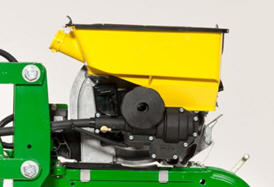 RowCommand on a MaxEmerge™ 5 row-unit
RowCommand on a MaxEmerge™ 5 row-unit
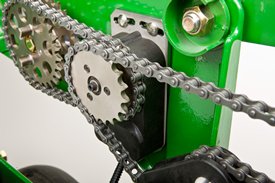 RowCommand on a chain drive MaxEmerge 5 row-unit
RowCommand on a chain drive MaxEmerge 5 row-unit
Controlling input costs and improving productivity are key producer requirements today. RowCommand is an effective, integrated John Deere solution designed to meet these intensifying needs. The RowCommand system manages seed output, reduces yield drag, and improves harvest capabilities on all Pro-Shaft™ driven row-units, and chain-driven MaxEmerge 5.
NOTE: Chain-drive RowCommand is only compatible with planters equipped with pneumatic downforce systems. On planters equipped with the heavy-duty downforce springs, potential chain interference may result and is not recommended.
NOTE: Chain-drive RowCommand requires some modification to brackets in order to function with corn finger pickup meters.
NOTE: Pro-Shaft drive RowCommand is compatible on MaxEmerge 5 row-units with vacuum and corn finger pickup meters. For mini-hopper row-units, RowCommand is compatible on vacuum meters only and is not compatible on corn finger pickup meters. Pro-Series™ XP row-units with corn finger pickup meters are not compatible with RowCommand.
RowCommand controls seed output by incorporating individual, low amperage clutches inside the Pro-Shaft and chain-driven gearboxes. Clutches are completely enclosed within the gearbox housing to protect them from the elements and harsh operating conditions.
When power is supplied, either manually or through John Deere Section Control software, clutches disengage the seed meters and seed flow stops. Controlling seed output at individual rows reduces overplanting in point rows and maximizes seed placement when entering/exiting headlands.
Components and operation
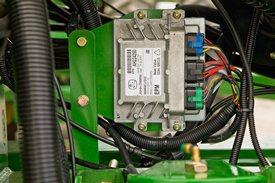 Electronic power modules shown on a 1775NT Planter
Electronic power modules shown on a 1775NT Planter
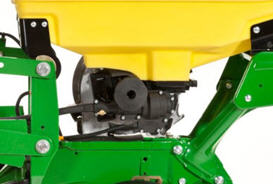 RowCommand clutch on MaxEmerge 5 with 105.7-L (3-bu) hopper
RowCommand clutch on MaxEmerge 5 with 105.7-L (3-bu) hopper
RowCommand is a simple and efficient solution to control individual row planting. This system does not utilize air to operate; therefore, no compressor, air lines, or valve modules are required.
RowCommand utilizes low-voltage controller area network (CAN) messaging to signal power to the desired clutches to stop planting or eliminates power to resume planting.
This means very little power is used in normal planting conditions, and in the event a clutch fails electrically, the meter will continue to plant.
The RowCommand system requires the following five basic components to operate:
-
Electric clutches
-
Electronic power modules (EPMs)
-
SeedStar™ 2 or XP monitoring (wedge box/controller)
-
GreenStar™ display
-
Planter wiring harnesses
Clutches are protected within the sealed Pro-Shaft and chain-driven gearboxes for years of trouble-free operation and simple installation or removal. RowCommand has true individual-row control of up to 16 clutches or sections for planters larger than 16 rows.
Unique to RowCommand, the 16 available control sections can be configured based on operator preferences. For example, on a 1775NT 24-Row Planter, every two rows can be paired together for a total of 12 control sections, or control the outermost eight rows individually and the remaining inner rows paired together for 16 control sections.
While SeedStar with RowCommand has 16 control sections, a minimum of 152.4-cm (60-in.) wide sections are recommended for optimum Swath Control Pro™ solution capabilities. As with other Swath Control Pro products, an SF2 signal is the minimum level of accuracy recommend for operation.
Chain-drive RowCommand and heavy-duty downforce
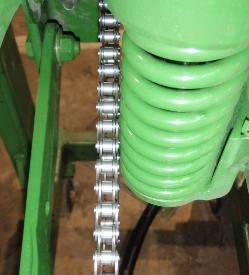 Chain interference with heavy-duty downforce
Chain interference with heavy-duty downforce
As seen in the image, chain interference may result when operating chain-drive RowCommand on planters equipped with short and long parallel arms and heavy-duty downforce springs.
NOTE: Chain-drive RowCommand is only compatible with planters equipped with pneumatic downforce systems. On planters equipped with the heavy-duty downforce springs, potential chain interference may result and is not recommended.
Chain-drive RowCommand with corn finger pickup meters
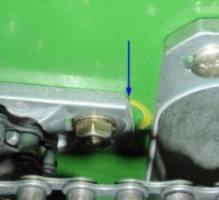 Bracket material removal
Bracket material removal
Due to the design characteristics of the chain-drive RowCommand clutch, some modification to the corn finger pickup meter drive bracket is required. As seen in the picture to the left, some material needs to be removed from the front of the meter drive bracket in order for the chain-drive RowCommand clutch to have sufficient space for installation.
NOTE: Chain-drive RowCommand requires some modification to brackets in order to function with corn finger pickup meters.
RowCommand ordering information
To add RowCommand to a model year 2009 and newer planter model listed above is simple. Pro-Shaft drive attachments for field conversion and chain-drive attachments for field conversion are available by planter model to add the appropriate number of clutches, EPMs, brackets, hardware and row-unit harnesses. For complete installation and part detail for the RowCommand conversion, please use the RowCommand compatibility tool per specific planter model.
RowCommand is compatible and available for model year 2003 (serial number 700101) to 2008 (725101) planter models listed above. In addition to the attachment for field conversion attachment, a planter mainframe harness, SeedStar 2 controller (wedge box), and additional CAN harnesses are needed.
Integrated Swath Control Pro
Coupling RowCommand with Swath Control Pro provides the ultimate in precision planting and productivity. One company and one integrated solution are what John Deere offers by incorporating Swath Control Pro capabilities within the SeedStar 2 wedge box (controller). Unlike previous systems, no rate controller, additional harnessing, or components are required to achieve automated individual-row control.
SeedStar 2 and XP monitoring, RowCommand, and Swath Control Pro activation from John Deere Precision Ag Technologies are all that is needed when ordering.
System requirements
RowCommand is a simple and efficient means to control individual row planting using low-voltage electric clutches. When activated, each clutch consumes no more than 0.5 amps. By design, power is only supplied to the clutch when a signal is received to stop planting. In a normal planting condition, no power is supplied, and the clutch is de-energized.
Power for the RowCommand system is provided from the nine-pin ISO implement connector. All late-model 8X00 and 9X00 Series and newer John Deere Tractors equipped with the nine-pin ISO implement connector can supply ample power for system operation.
Along with ample system power, a GreenStar display and SeedStar monitoring are required for operation and control interface. The GreenStar display is where system setup, control settings, and manual control functions are performed.
Pneumatic downforce provides convenient, simple adjustment of downforce for the whole planter from one location. The amount of downforce applied is infinitely adjustable from 0 kg to 181.4 kg (0 lb to 400 lb). Pneumatic downforce provides more consistent downforce throughout the range of row-unit travel than mechanical spring downforce systems.
Several pneumatic downforce system improvements have been implemented, including:
- 9.5-mm (3/8-in.) air delivery line instead of the 6.4-mm (1/4-in.) line used on model year 2010 and older planters.
- Air compressor assembly increased duty cycle. With this compressor, it provides a 47 percent increase in maximum air flow delivery compared to the prior air compressor.
- Pneumatic air bags with 9.5-mm (3/8-in.) air line inlets that have greater durability.
Such improvements to the pneumatic downforce system enable faster and more precise control of row-unit downforce while planting.
System features
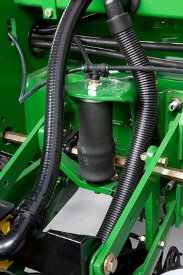 Pneumatic downforce spring
Pneumatic downforce spring

Each row-unit has a single, rubber air bag located between the parallel arms. The air bags are hooked in parallel so that air can be added or released from all rows at once from one location.
Pneumatic downforce systems are available as base equipment on all 1700 Series and DB Planters. The individual pneumatic downforce air bag assemblies, air compressor units, and 9.5-mm (3/8-in.) delivery lines are also available as an attachment for field conversion.
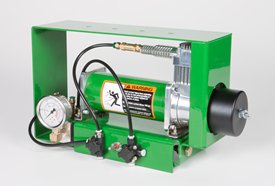 Pneumatic downforce compressor and gauge
Pneumatic downforce compressor and gauge

An improved compressor is used to charge the pneumatic system. This compressor can be located on the planter frame or in the tractor cab if desired. A gauge at the compressor indicates the amount of downforce being applied.
From the factory, integral planter models with pneumatic downforce will have an improved air compressor assembly with an in-cab mounting bracket, except the 1725 16Row and 1725 Central Commodity System (CCS™) Twin-Row Planters which will have the air compressor assembly mounted on the planter frame. For drawn planter models, the 1755, 1765, 1765NT, 1775 Front-Fold, and 1785 Drawn Planters will have the air compressor assembly installed either on the outer hitch or wing frame members when the pneumatic downforce system is installed.
Crop yields have increased through the years along with the amount of residue left in the field after harvest. At the same time, tillage practices have changed, including different tillage operations which maintain large amounts of surface residue, and even no-till practices. Row cleaners are an essential tool in managing this increased amount of residue.
John Deere seeding group offers a variety of row cleaner options to meet the needs of a producer's operation. Compatibility varies by model, row spacing, and other planter equipment.
Screw-adjust, unit-mounted row cleaner
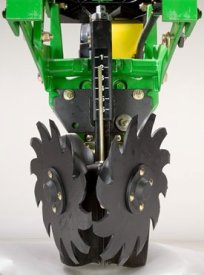 Screw-adjust, unit-mounted row cleaner
Screw-adjust, unit-mounted row cleaner
The screw-adjust, unit-mounted row cleaner is mounted directly to the face plate of the row-unit, placing the ground engaging components just in front of the row-unit opener blades and depth gauge wheels. This close proximity allows the gauge wheels to control the depth of the row cleaner as well as the row-unit. This compact design also allows greater compatibility with fertilizer openers and other planter attachments.
SharkTooth® wheels are standard equipment on the unit-mounted row cleaner. The swept-tooth design of the wheel provides a clear path for the row-unit openers while resisting residue buildup on the wheel. The screw adjustment knob is accessible through the top of the parallel arms, providing convenient access for adjustments. The row cleaner can be adjusted in 1.6-mm (1/16-in.) increments, providing plenty of flexibility to meet the needs of changing conditions.
Floating row cleaner with unit-mounted coulter
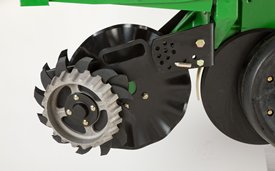 Floating row cleaner with unit-mounted coulter
Floating row cleaner with unit-mounted coulter
The floating row cleaner allows a row cleaner to be used in conjunction with a unit-mounted coulter. This combination is often desired in heavy residue loads and reduced tillage planting conditions. The row cleaner provides a clear path for the row-unit, while the unit-mounted coulter helps penetrate tough soil conditions.
Accommodating the unit-mounted coulter means the residue wheels are farther forward from the row-unit face plate than in the case of the screw-adjust row cleaner. To maintain performance, this row cleaner has the capability to float above a defined minimum depth.
Standard depth-gauging bands on the wheels allow the row cleaner wheels to float independently of the row-unit openers, allowing both to perform in varying terrain. The unit may also be set in a fixed position by simply pinning through the bracket if desired. This row cleaner also features SharkTooth wheels as standard equipment.
The floating row cleaner and unit-mounted coulters are available on many planters as factory-installed equipment.
NOTE: Screw-adjust row cleaners are not compatible with MaxEmerge™ 5e row-units with long parallel arms.
NOTE: DB models have the option for either unit-mounted coulter, screw-adjust row cleaners, or pneumatic row cleaners (only compatible with MaxEmerge 5e or equipped ExactEmerge™ models). The DB60T is only available with a less row cleaner option.
SharkTooth is a trademark of Yetter Manufacturing, Inc.
Seed variable-rate drive provides the ultimate planting productivity by utilizing one, two, or three hydraulic motors (varies by model) to turn the seeding drive shaft. Hydraulic control of the seeding drive allows for on-the-go seeding rate changes right from the display mounted inside the tractor cab. Combine this seeding flexibility with the map-based planting option, and seeding rates adjust automatically based on the prescribed map.
Variable-rate drive offers the following advantages over common, ground, or contact-tire drive systems:
-
Rate changes are almost instantaneous; no ramp up or ramp down of system as in some competitive systems
- Permits the producer to match seed population based on different soil types or irrigation practices
- John Deere design provides added operator safety by eliminating any possible drive creep found in some competitive variable-rate drive systems
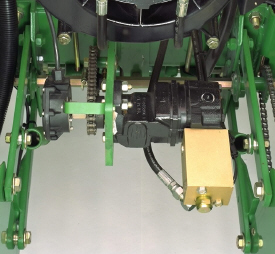 1755 equipped with variable-rate drive
1755 equipped with variable-rate drive
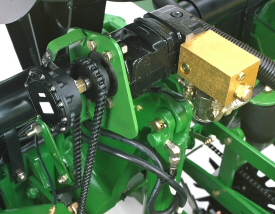 1765NT equipped with variable-rate drive
1765NT equipped with variable-rate drive
Single- or dual-motor systems for variable-rate drives are available for all John Deere planters except the 1785 Rigid Frame. Variable-rate drive is available as a factory-installed option for all applicable planter models.
Single- or dual-motor systems are available as field-installed attachments for most planter models; however, a three-motor variable-rate drive field-installed attachment is not available.
Seed variable-rate drive requires the SeedStar™ monitor and a radar input signal. Either tractor or planter radar may be used. Planter radar is ordered separately.
NOTE: Peanut seed meter disks require the variable-drive transmission.
MaxEmerge 5 bundles the best of MaxEmerge XP and Pro-Series™ XP row-units to give you a unique planter solution. With more options and configurations, you’ll get difference-making versatility that easily adapts to your ag management plan.
It starts with optimal seed population that drives yield potential. An improved double eliminated helps achieve your desired population with a ride range of crop sizes. Improved side-hill performance of up to ¼ degree ensures you receive the full value of each seed when planting on terraces or rolling terrain. The vacuum air source from the Central Commodity System (CCS™) tank in the meter provides a debris-free environment for increased meter efficiency.
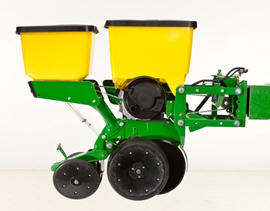 MaxEmerge 5 with 56-L (1.6-bu) hopper plus insecticide
MaxEmerge 5 with 56-L (1.6-bu) hopper plus insecticide
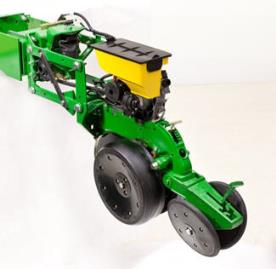 MaxEmerge 5 with mini-hopper on CCS™ machines only
MaxEmerge 5 with mini-hopper on CCS™ machines only
The MaxEmerge family of row-units have never seen a more versatile and efficient design until the MaxEmerge 5. The 5-family row-units improve productivity, increase uptime and lower the cost of ownership like never before.
The MaxEmerge 5 row-unit was designed for improved performance and serviceability.
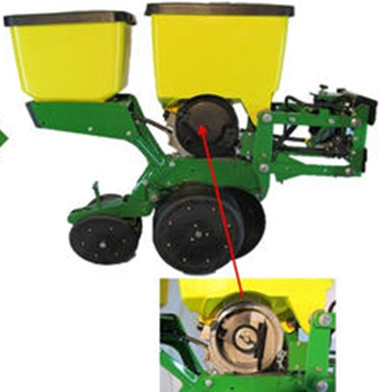 Easily access the meter
Easily access the meter
Serviceability and changing crops have always been a focus of downtime and potential seed loss. The MaxEmerge 5 meter (shown on the right) is accessible without having to remove the box. The design allows large hoppers to be cleaned out the same as mini-hoppers, simply by opening the meter dome and catching the seed as it falls out.
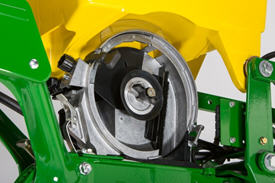 MaxEmerge 5 vacuum seed meter
MaxEmerge 5 vacuum seed meter
The vacuum meter system gently pulls and holds individual seeds to the holes of the seed disk for population control and spacing accuracy, equaling better crop stands and profit. Vacuum seed meters can plant a wide variety of crops and seed types by simply changing seed disks and adjusting vacuum level. Vacuum seed meters are available for planters with MaxEmerge 5 row-units.
Additional features of the vacuum seed meter include:
- One moving component (the seed metering disk) for minimum maintenance requirements
- Meter located at each row-unit for accurate seed delivery
- Good hopper seed flow characteristics for longer operating time per hopper fill
- Low airflow in meter so seed treatments are not removed
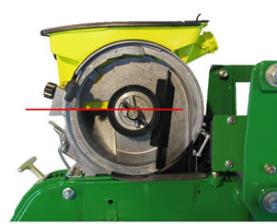 MaxEmerge 5 seed pool
MaxEmerge 5 seed pool
The MaxEmerge 5 meter shape has also been redesigned for better seed flow. The mini-hopper design allows the planter to successfully operate on side hills up to 14 degrees.
Vacuum meter hub and latching handle
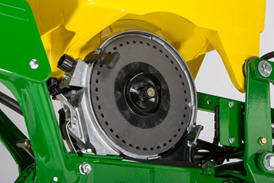 MaxEmerge 5 vacuum meter with disk
MaxEmerge 5 vacuum meter with disk
Both the MaxEmerge 5 vacuum meters are equipped with a heavy-duty hub spring and disk latching handle. The spring ensures the seed disk stays properly positioned when operating flat-style seed disks and higher vacuum levels. Proper seed disk positioning means repeatable seed singulation, time after time. The disk-latching handle is designed for easy operation and effortless seed disk changeover. The hub is also machined to tight tolerances to further ensure alignment of metering components.
Operating characteristics of vacuum seed meter
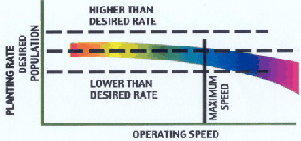 Operating speed with seed tube technology
Operating speed with seed tube technology
The vacuum seed meter can operate at faster planting speeds than mechanical meters. However, planting accuracy will be influenced by seedbed conditions and the operating characteristics of the seed meter. Rough seedbeds and fast planting speeds (above 8.9 km/h [5.5 mph]) typically deteriorate seed placement accuracies when using seed tube technology.
The chart illustrates the effect operating speed has on population when using the vacuum meter. The operating band (color area) illustrates how the vacuum meter performs in relation to the desired population (indicated by horizontal line). The width of the band is due to various sizes and shapes of seeds and planting rate variations.
When operating on slopes above 15 degrees, increased or decreased population may result. To minimize this effect, reduce speed and consider using a flat style seed disk with increased vacuum level.
Vacuum meter seed disks
The ProMax 40 Flat Disk is a flat-disk planting solution field-proven to work since 1991.
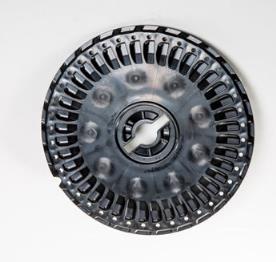 ProMax 40 Flat Disc
ProMax 40 Flat Disc
The design of the ProMax 40 Flat Disk position allows seed to be released from the optimum position above the seed tube. The flush-face seed tube allows the seed to drop uninterrupted through the tube.
The ProMax 40 Flat Disk utilizes flat holes and a higher vacuum level to ensure every hole is populated with a seed. A double eliminator gently removes multiple seeds at each hole for precise population control. A knockout wheel makes certain that each hole is clear of any debris after the seed is released from the disk.
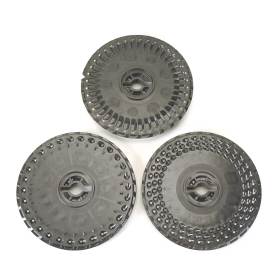 Flat-style and cell seed disks shown
Flat-style and cell seed disks shown
The unique cell disk design allows planting a variety of seed sizes without any additional parts or individual meter adjustments. Another advantage of cell-type seed disks is the lower vacuum requirement compared to flat-style seed disks. Lower vacuum levels mean less hydraulic demand from the tractor. Most planting conditions call for a flat disk, if you are limited in hydraulic capacity, cell disks are recommended.
Double eliminator
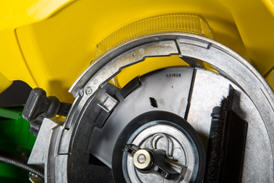 Flat seed disc and double eliminator
Flat seed disc and double eliminator
For difficult to singulate seeds, a flat seed disk and double eliminator is a viable alternative to traditional cell-type seed disks. By design, a flat seed disk requires higher levels of vacuum than a cell-type disk because there is no pocket or cell to hold the seed. The higher vacuum level will pull more than one seed to the holes in the seed disk. The double eliminator is set to cover a portion of the hole in the seed disk and is the mechanism to knock multiple seeds away as the disk rotates.
Double eliminators are required with flat-type seed disks only and should not be used with cell-type seed disks. The knockout wheel is also recommended in conjunction with the double eliminator and flat seed disk to ensure seed is ejected from the disk.
Flat and celled type seed metering disks are available to allow planting a wide variety of seed types.
- Corn (field, popcorn, or sweet corn)
- Soybeans
- Cotton
- Sorghum
- Sugar beets
- Sunflowers
- Edible beans/peas
- Peanuts
- Melons, squash, cucumbers
Mini-hopper row-units, which are used only with the CCS, are compatible only with crops that the CCS is approved to plant.
- Corn
- Popcorn
- Sweet corn
- Soybeans
- Sunflowers
- Sorghum
- Cotton
NOTE: Due to small seed size and low planting populations, sugar beets can be planted with mini-hopper style meters by adding hopper extensions and not using the CCS tank. These hopper extensions can also be used for planting test plots.
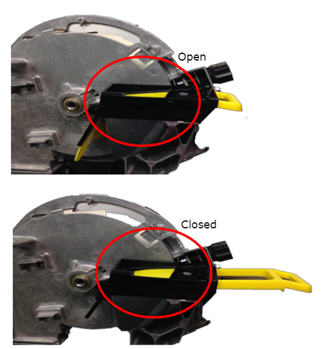 Hopper shutoff
Hopper shutoff

Also, to help with meter access of 56-L and 106-L (1.6-bu and 3-bu) hoppers the hopper shutoff feature was added. With the shutoff engaged, the meter cover can be opened without first having to remove all the seeds from the hopper. Lever down, the seed flow is on, lever horizontal and the seed flow is off.
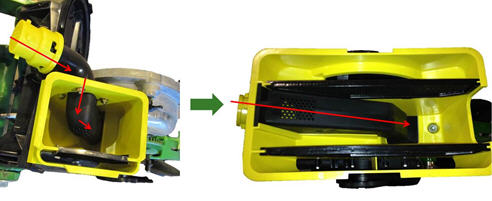 MaxEmerge 5 mini-hopper
MaxEmerge 5 mini-hopper

There are significant changes to the MaxEmerge 5 mini-hopper. One update is the straight feed from the CCS hose to the mini-hopper to ensure a continuous free flow of seeds. This design change reduces the potential for plugging issues with larger seed size and the use of seed treatments. By drawing air from the CCS tank, the vacuum source is cleaner, preventing meter debris buildup.
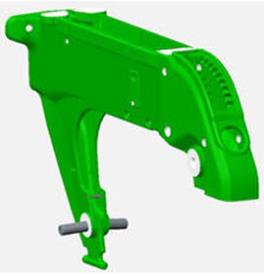 Ductile iron-cast shank
Ductile iron-cast shank
Ductile iron casting is a unique high-tech process that produces a single-piece row-unit shank this enables alignment from the seed trench to the closing wheel.
The row-unit head is also designed using the ductile iron-casting process. The row-unit head provides the mating joints between the row-unit parallel arms and the row-unit shank. It is also the upper attaching point for the seed meter and seed hopper.
Ductile iron casting of the row-unit shank and head assembly provides a row-unit that is 25 percent stronger than other competitive welded row-units.
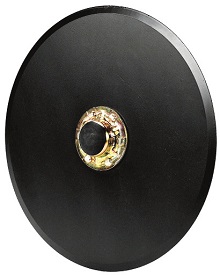 Tru-Vee opener blade
Tru-Vee opener blade
One of the trademark capabilities of John Deere planters has always been the ability of the Tru-Vee openers to provide an ideal seed furrow.
The thickness of the Tru-Vee opener blade is 3.5 mm (0.14 in.) this blade thickness will provide extended wear life.
The MaxEmerge 5 row-unit also provides better Tru-Vee opener bearings for longer life. The double-row ball bearing provides up to three times the wear life as the single-row bearing.
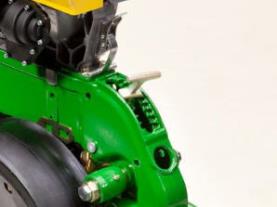 Depth adjustment T-handle
Depth adjustment T-handle

John Deere planters provide consistent seed depth control in all field conditions. Depth control is a function of the Tru-Vee openers, the downforce system, and the gauge wheel assembly.
The gauge wheel itself is made of durable nylon composition with a concave profile. This profile gently firms the sides of the seed furrow, ensuring a well-defined trench. The shape reduces rocks and residue being picked up and thrown onto the drive chains and row-units, and helps to prevent rooster tailing of soil.
The bolt-through design utilizes an open bearing in the gauge wheel that allows an attaching bolt to pass through the wheel to the threaded hole in the gauge wheel arm. This simple bolt-through design provides for a positive attachment of the gauge wheel to the gauge wheel arm and allows quick removal of the gauge wheel for service.
Adjustability of the row-unit is critical to good performance. More available downforce options than any row unit in the industry
- Adjustable heavy-duty downforce, four settings, 0 kg (0 lb), 57 kg (125 lb), 113 kg (250 lb), and 181 kg (400 lb) of downforce
- Pneumatic downforce, infinitely variable from 0 to 181 kg (0 to 400 lb) of downforce
- Active pneumatic downforce adjusts automatically for changing ground conditions from 0 to 181 kg (0 to 400 lb) of downforce
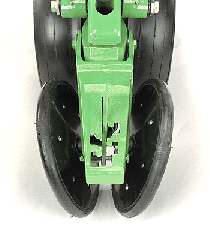 Rubber tire closing system
Rubber tire closing system
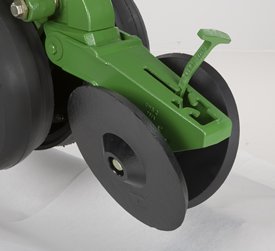 Cast wheel closing system
Cast wheel closing system
Rubber tire closing systems are used for most conventional, minimum-till, and no-till planting conditions. The spacing between the wheels is adjustable so the closing system can meet the needs of those who want to plant small seeds at shallow depths.
The wheels can also be staggered fore and aft to enhance residue flow. Four levels of spring force are available and are easily set with the integrated T-handle adjustment. A lower force spring can be obtained from parts, if a lower amount of force is required.
Additional closing wheel options include:
- Cast closing wheels for tough-to-close conditions
- Disk closing, for shallow planting depths
- Closing wheel frame less wheels for growers desiring to use aftermarket closing wheels
Convenient, stack-folding design combined with rigid or flexible frame
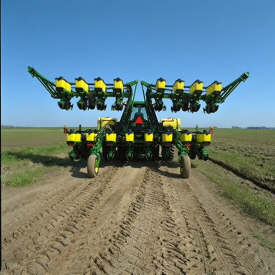 1725 16Row30 Stack-Fold Planter
1725 16Row30 Stack-Fold Planter
The 1725 Stack-Folding design provides narrow transport capability for these integral, large-frame planters without the need to empty hoppers. The 1725 Stack-Folding Planter has both rigid-frame and flex-frame configurations.
Three-section flex frames, available on 8-row wide and 12Row30 planters, flex 5 degrees up and 5 degrees down. The 16Row30 also utilizes a three-section frame that flexes 10 degrees up and 7 degrees down.
The 12-row wide planters with 91.4-cm, 96.5-cm, or 101.6-cm (36-in., 38-in., or 40-in.) spacings are equipped for rigid operation but can be modified in the field to provide frame flex. Productivity is improved with in-cab fold and go. Stack-folding frames utilize side-fold markers or can also be ordered without markers.
Lift-assist wheels may be required on 1725 Planters; check Tractor Compatibility Guide (1725 Stack-Folding Planter—Tractor Hitch Lift and Front Ballast Requirements).
The 1725 Stack-Fold Integral Planter is available in the following models:
-
8Row36, 8Row38, or 8Row40
- 12Row30, 12Row36, 12Row38, or 12Row40
- 16Row30
Transportability
| Model | Transport width with markers | Transport height* |
| 8Row - 91.4 cm (36 in.) | 5 m (16 ft, 5 in.) | 3.4 m (11 ft, 2 in.) |
| 8Row - 96.5 cm or 101.6 cm (38 in. or 40 in.) | 5.3 m (17 ft, 5 in.) | 3.4 m (11 ft, 2 in.) |
| 12Row - 76.2 cm (30 in.) | 6.2 m (20 ft, 3 in.) | 3.6 m (11 ft, 8 in.) |
| 12Row - 91.4 cm (36 in.) | 5.9 m (19 ft, 6 in.) | 4.04 m (13 ft, 3 in.) |
| 12Row - 96.5 cm or 101.6 cm (38 in. or 40 in.) | 7.2 m (23 ft, 8 in.) | 4.04 m (13 ft, 3 in.) |
| 16Row - 76.2 cm (30 in.) | 8.1 m (26 ft, 8 in.) | 4.01 m (13 ft, 2 in.) |
| *Height measured with 18.4R-46 rear tires on tractor | ||
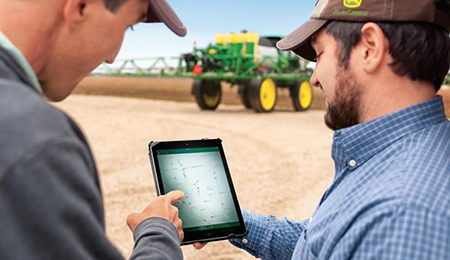 Connected Support technology
Connected Support technology
When you buy John Deere equipment, you expect reliability. You also know that problems can happen, and a product is only as good as the support behind it. That’s why John Deere equipment is prepared with technology that senses potential issues and can alert you and your dealer promptly—in the cab or anywhere you are.
John Deere Connected Support is a revolutionary change to support that leverages technology and the connectivity of JDLink™ telematics to prevent downtime and resolve problems faster. These tools decrease downtime by an average of 20 percent, enabling faster responses to unexpected problems and reducing technician trips to your machine. For some issues, unplanned downtime can even be prevented altogether through prediction of the issue.
With your permission, John Deere Connected Support:
- Keeps you running by monitoring machine health and promptly alerting you and your dealer of issues
- Saves time by remotely viewing in-cab displays, reducing trips to the machine
- Reduces or even eliminates technician trips to a machine through remote diagnostic and remote software reprogramming capabilities
- Connects experts with the information needed to respond to downtime faster and prevent it altogether
With more than a decade of experience leveraging connectivity to solve problems, no one else has the experience, tools, and knowledge to keep you running as John Deere and your John Deere dealer can. Connected Support is an in-base feature on all John Deere products with factory- or field-installed JDLink.
Specs & Compare
Key Specs | 1725 Integral Stack-Fold Current Model |
| Number of rows | 8, 12 |
| Row spacing | 8 Row Narrow: 91.4 cm 36 in. 8 Row Wide: 96.5 or 101.6 cm 38 or 40 in. 12 Row Narrow: 76.2 or 91.4 cm 30 or 36 in. 12 Row Wide: 96.5 or 101.6 cm 38 oz |
| Frame - Fold configuration | Stack-folding |
| Frame - Flexibility | Up: 10 degree (angle) Down: 7 degree (angle) |
| Row unit seed hoppers | Mini-Hoppers |
| Seed Meters | Base Vacuum |
Rows and Row Spacing | |
| Number of rows | 8 or 12 |
| Row spacing | 8 Row Narrow: 91.4 cm 36 in. 8 Row wide: 96.5 or 101.6 cm 38 or 40 in. 12 Row narrow: 76.2 or 91.4 cm 30 or 36 in. 12 Row Wide: 96.5 or 101.6 cm |
Frame | |
| Fold configuration | Stack-folding |
| Frame tube size | |
| Fold-and-go from tractor cab | |
| Flexibility | Up: 10 degree (angle) Down: 7 degree (angle) |
Hitch | |
| Base | |
| Optional | |
| Rear hitch | |
Lift System | |
| Type | Semi-integral only |
| Number of cylinders | |
Tires | |
| Base | 12.5L-15SL 20 ply implement: 303 kPa 3.0 bar (44 psi) 7.60-15 8 ply implement: 359 kPa 3.6 bar (52 psi) 7.6-15 6 ply - traction: 276 kPa 2.8 bar (40 psi) |
| Optional | |
| Quantity | |
Row Units | |
| Type | |
| Opener | Tru-Vee Double Disk |
| Depth gauging | |
| Adjustment | |
| Walking wheels | |
| Row unit seed hoppers | Mini-Hoppers |
| Row unit down force | Adjustable heavy-duty ---- |
| Scrapers, opener blades | |
| Seed tube sensors | |
Seed Meters | |
| Base | Vaccum |
| Optional | |
| Finger pickup | |
| Radial bean meter | |
| Central Commodity System | Seed capacity Two CCS™ bulk tanks each with capacity of: 1762 L 50 bu |
Drive System | |
| Base | 56 V electric drive |
| Optional | |
| Number of drive wheels | |
| Drive wheel disconnect | |
| Counter shaft | |
| Drill shaft | |
| Seed transmission | |
| Transmission combinations | |
Markers | |
| Type | |
| Control | |
| Marker disk | |
| Shear bolt protection | |
| Less marker option | |
Closing System | |
| Rubber tire closing system | |
| Cast iron closing system | |
Herbicide and Insecticide | |
| Insecticide only hopper | |
| Herbicide only hopper | |
| Insecticide and herbicide hopper | |
Liquid Insecticide System | |
| System available | |
| Tank capacity | |
Seed Monitor System | |
| Base | SeedStar™ electronic system |
| Optional | |
Tillage Attachments | |
| Unit-mounted coulter | |
| Frame-mounted coulter | |
| Bubble blade | |
| .63-in. fluted blade (25 flutes) | |
| .7-in. fluted blade (13 flutes) | |
| 1-in. fluted blade (8 flutes) | |
| Row tillage support hanger | |
| Tine tooth | |
| Cons. furrower w/ leading cutout blade | |
| V-wing bed sweeps | |
| Row cleaner | |
| Row cleaner - unit-mounted coulter | |
| Row cleaner - unit-mounted DD fert. opener | |
Fertilizer | |
| Onboard / towed / tractor tanks | |
| Tank capacity | |
| Fixed-rate application | |
| Variable-rate application | |
| Pump type | |
| Pump rate | |
| Fertilizer opener type | |
| Flow divider distribution system | |
| Pressure manifold distribution system | |
| Dry fertilizer | |
Dimensions | |
| Transport width (with markers) | |
| Transport width (without markers) | 8 Row 91.5 cm (36 in.): 50 m 16.42 ft 8 Row 96.5 or 101.6 cm (38 or 40 in.): 5.3 m 17.42 ft 12 Row 76 cm (30 in.): 6.2 m 20.25 ft 12 Row: 91.5 cm (36 in.): 5.9 m 19.5 ft 12 Row 96.5 or 101.6 cm (38 or 40 in.): 7.3 m 23.67 ft |
| Transport length | |
| Transport height | 8 Row 91.5 cm (36 in.) 3.4 m 11.17 ft 8 Row 96.5 or 101.6 (38 or 40 in.): 3.4 m 12 Row 76 cm (30 in.): 3.6 m 11.67 ft 12 Row 91.5 cm (36 in.): 4.1 m 13.25 ft 12 Row 63.5 or 101.6 cm (38 or 40 in.): 4.1 m 13.17 ft |
| Transport weight | |
| Transport underframe clearance | 4 m 13.2 ft On 8000 Series tractors with 18.4-42 tires |
| Field operation width | |
| Field operation length | |
Ag Management Solutions | |
| Map-based seeding | |
| Field documentation | |
| Parallel tracking | |
Additional Information | |
| Recommended tractor horsepower | Vaccum system hydraulic drive: horsepower required: 4.5-10.4 kW 6-14 hp Minimum tractor size: 201 kW 270 hp Tractor recommendation: Currrent model (minimum) 8430 MFWD with dual rear tires and 20 front weights. |
| Recommended tractor hydraulics | Hydraulic oil required to operate the planter: 227 L/min 60 gpm Hydraulic system standby pressure: 15,513 kPa 155 bar (2250 psi) Hydraulic system working pressure: 20,684 kPa 207 bar (3000 psi) Hydraulic system burst pressure: 82,737 kPa 827 bar (12,000 psi) |
| Warranty length | |
| Date collected |
Offers & Discounts
Videos
© COPYRIGHT 2025 SMITH TRACTOR CO. EQUIPMENT - ALL RIGHTS RESERVED| Privacy Policy | Powered By













